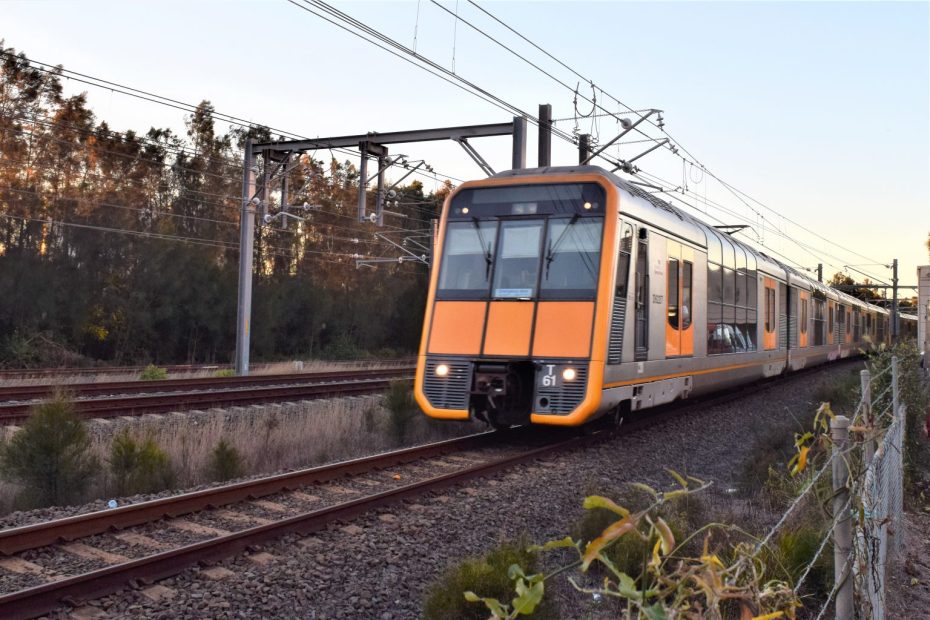Executive Summary
The reconstruction of Pippita Station on the Olympic Park rail loop, combined with the creation of a Pippita Rail Trail, represents an opportunity to deliver a cost-effective yet transformative infrastructure project for Greater Sydney. The proposal re-establishes Pippita as a modern commuter station while simultaneously unlocking underutilised rail infrastructure and supporting large-scale housing and urban renewal.
At present, the Olympic Park line operates only as a shuttle between Lidcombe and Olympic Park, used primarily during major events. This results in an expensive asset lying dormant outside peak periods. By reinstating Pippita Station and implementing through-running services between Lidcombe, Pippita, Olympic Park, Strathfield, and Central, the corridor can be integrated into the wider Sydney Trains network as a productive daily commuter route.
The project’s transport benefits align directly with housing delivery goals. The Carter Street Precinct, immediately adjacent to the Pippita alignment, is zoned for 5,500 dwellings, accommodating around 10,000 new residents. Sydney Olympic Park is projected to grow to 23,000 residents and 34,000 jobs by 2030. In addition, renewal of the Lidcombe North and Parramatta Road corridor has the potential to deliver a further 4,000–6,000 dwellings. Taken together, the corridor could support 12,000–16,000 dwellings, of which around 2,000 could be delivered as affordable or key worker housing through inclusionary planning mechanisms.
The Pippita Rail Trail, proposed as a three to four kilometre active transport corridor running parallel to the rail alignment, would connect Carter Street, Lidcombe North, Duck River, Parramatta Road, and Sydney Olympic Park. This would provide a continuous and safe walking and cycling link that complements rail patronage and addresses current gaps in the metropolitan cycle network.
The estimated project cost, based on comparable Sydney Trains projects and adjusted for 2025 inflation, is $180–280 million, which includes a 30 per cent allowance for potential overruns. Within this cost envelope, the project offers strong value for money, supporting a benefit–cost ratio in the range of 1.6 to 2.0 when transport, housing, social, and environmental benefits are considered.
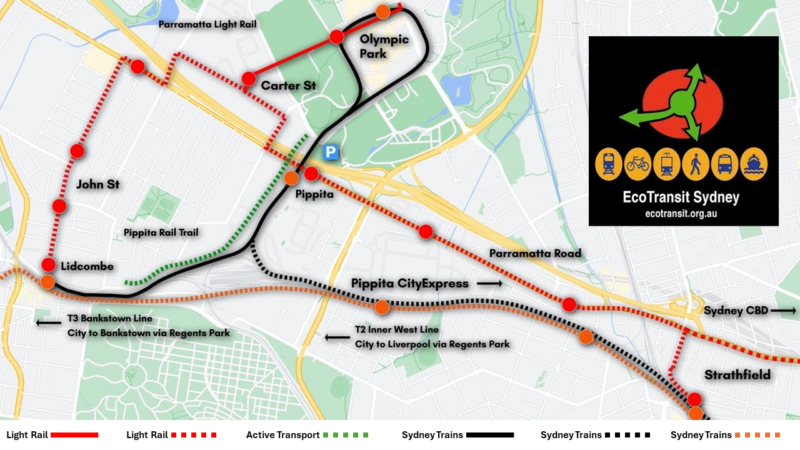
Strategic Context
Sydney faces pressing challenges around housing supply, congestion, and sustainability. The NSW Housing Accord requires the delivery of 378,000 homes by 2040, with a particular emphasis on well-located, rail-accessible precincts. Carter Street has already been identified by the NSW Government as a major housing growth precinct, while Sydney Olympic Park is recognised as a Strategic Centre under the Greater Sydney Region Plan. However, both precincts currently lack sufficient transport connectivity.
The Future Transport 2056 strategy establishes a vision of a “30-minute city” where residents can access jobs and services within half an hour by public transport. Without Pippita Station, Carter Street residents face a 15–20 minute walk to Lidcombe or Olympic Park stations, effectively discouraging public transport use and pushing them towards car dependency. This undermines both liveability and the Government’s Net Zero Plan Stage 1, which requires major reductions in transport emissions through mode shift.
In addition, Lidcombe Interchange is already one of the busiest suburban stations in Sydney, acting as a convergence point for the T1, T2, T3, and T7 lines. With continued growth in South-West Sydney and Cumberland LGA, Lidcombe’s interchange pressures will worsen, further limiting its ability to serve the Carter Street population.
At the same time, the Olympic Park Line remains an underutilised investment. Constructed in the 1990s at significant cost, its current usage is limited to a short shuttle service and event traffic. Re-opening Pippita and enabling through-services to Strathfield and Central would transform this line from an idle event asset into an integral part of the suburban rail network.
Problem Definition
The core problem is that the Carter Street, Olympic Park, and Lidcombe North precincts are not well served by rail. Residents of Carter Street face a walk of over one kilometre to existing stations. Workers in the Lidcombe North employment area lack direct rail access, constraining economic development. Olympic Park itself has a world-class station but one that is significantly underutilised outside major events.
Without intervention, 10,000 new Carter Street residents will rely heavily on cars, further burdening Parramatta Road and the M4. Lidcombe Interchange will experience worsening congestion as more passengers funnel through an already constrained hub. The economic uplift potential of Lidcombe North renewal will remain unrealised, and housing affordability outcomes will be weaker without integrated transport provision.
Project Objectives
The objectives of the project are to:
- Provide direct rail access for residents of Carter Street and workers in Lidcombe North.
- Enable through-services to Sydney CBD via Strathfield, maximising the Olympic Park loop.
- Relieve congestion at Lidcombe Interchange.
- Support delivery of 12,000–16,000 dwellings, including up to 2,000 affordable units.
- Provide a safe, continuous active transport link via the Pippita Rail Trail.
- Advance the NSW Government’s housing, affordability, and Net Zero targets.
Project Scope
The project consists of two main components. The first is the reconstruction of Pippita Station itself. The new station would comprise two eight-car platforms, a concourse with lifts, ramps, and stairways, and accessible pathways linking into Carter Street and Parramatta Road. The station would also include cycle parking, kiss-and-ride facilities, and integration with local bus services.
The second component is the Pippita Rail Trail. This would be a three to four kilometre shared walking and cycling path adjacent to the rail alignment. It would connect Carter Street and Lidcombe North to the Duck River corridor and Sydney Olympic Park, with bridges and underpasses to ensure safe crossings of Parramatta Road and watercourses.
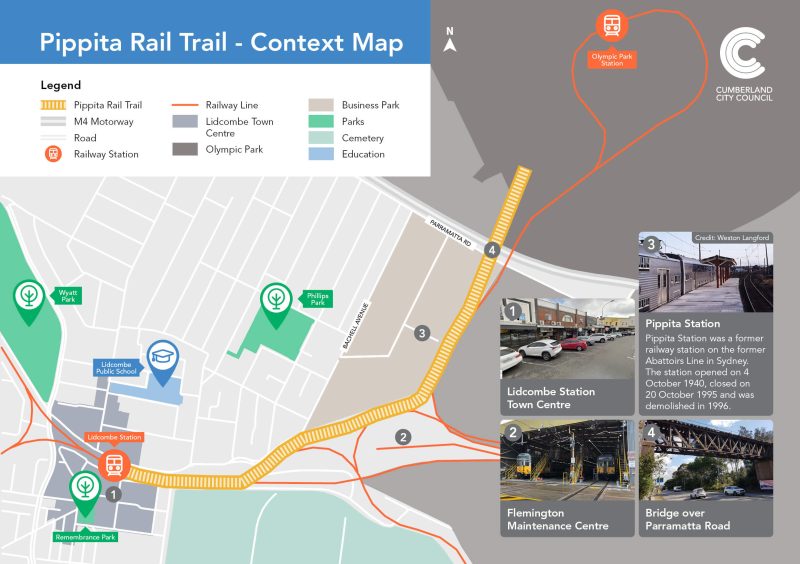
Rail Operations and Technical Analysis
The Olympic Park Line is a dual-track balloon loop branching from Lidcombe, with the potential for services to run from Lidcombe to Olympic Park and then back via Strathfield into the City. Currently, services are confined to a shuttle between Lidcombe and Olympic Park, using Waratah A/B sets in an eight-car configuration.
Re-opening Pippita Station allows the introduction of through-running services. These would operate as Lidcombe → Pippita → Olympic Park → Pippita (loop return) → Strathfield → Redfern → Central. In operational terms, this would require timetable adjustments at Strathfield Junction, where two to four additional trains per hour could be absorbed with careful planning.
Capacity analysis indicates that by 2041, Pippita would accommodate around 1,200 passengers per peak hour, well within the loop’s capacity. Olympic Park would remain the primary event hub, with Pippita serving daily commuters and local passengers, ensuring crowd management during major events is not compromised.
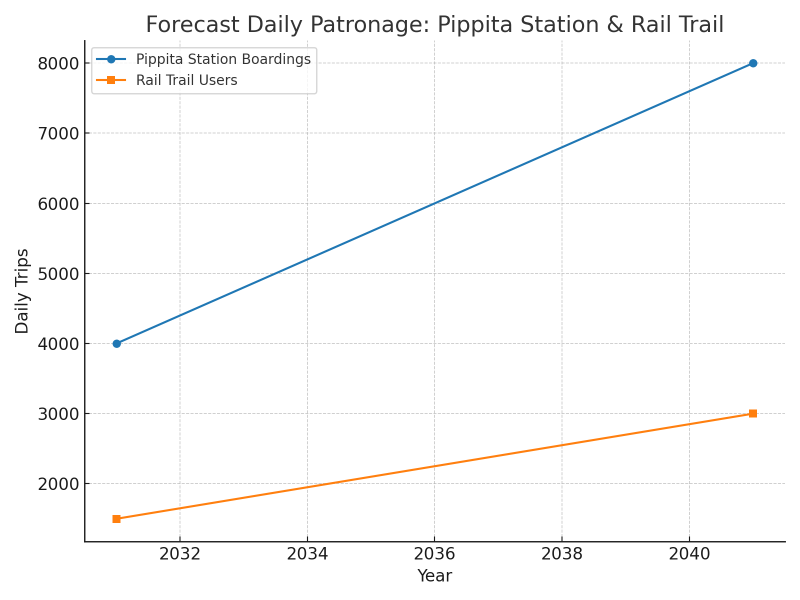
Housing and Urban Renewal Opportunities
The Carter Street Precinct provides for 5,500 new dwellings, housing approximately 10,000 residents. With appropriate planning mechanisms, up to 15 per cent of these units could be secured as affordable housing, delivering around 825 affordable or key worker homes.
Sydney Olympic Park’s Masterplan 2030 targets 23,000 residents and 34,000 jobs. Pippita would serve the eastern portion of this precinct, increasing accessibility and resilience of the network.
Lidcombe North and the Parramatta Road corridor represent significant renewal potential. Currently occupied by logistics and low-yield commercial uses, the area could be rezoned for mixed-use medium-rise development. With Pippita Station as a catalyst, this area could accommodate between 4,000 and 6,000 dwellings over 20 years, with 600–900 dwellings secured as affordable.
In total, the corridor could deliver between 12,000 and 16,000 new dwellings, with 1,875–2,175 dwellings earmarked as affordable housing.
Demand Forecast
Demand modelling suggests that by 2031, Pippita would record approximately 4,000 daily boardings, increasing to around 8,000 daily boardings by 2041 as Carter Street fills out and Lidcombe North renewal accelerates. These figures are comparable to the early patronage of Sydney Trains infill stations such as Edmondson Park, Leppington, Holsworthy, and Wolli Creek, all of which experienced rapid growth once surrounding housing precincts matured.
The Pippita Rail Trail is expected to attract around 1,500 daily walking and cycling trips by 2031, rising to 3,000 trips per day by 2041. These would include first-mile/last-mile access to rail as well as local recreational journeys.
Costs and Benefits
The cost of reconstructing Pippita Station is estimated at $140–170 million, with a risk allowance increasing this to $220 million. The Pippita Rail Trail is costed at $36–46 million, with a risk allowance up to $60 million. The combined project envelope is therefore $180–280 million.
The benefits include significant transport time savings for Carter Street residents (five to ten minutes per trip compared with walking to Lidcombe), congestion relief at Lidcombe Interchange, housing delivery capacity for up to 16,000 dwellings, and the provision of around 2,000 affordable units. Environmental benefits include substantial reduction in car trips and associated emissions. Social benefits include increased accessibility for low-income residents and better community cohesion through active transport.
The indicative benefit–cost ratio is in the range of 1.6–2.0, representing a strong value for money case.
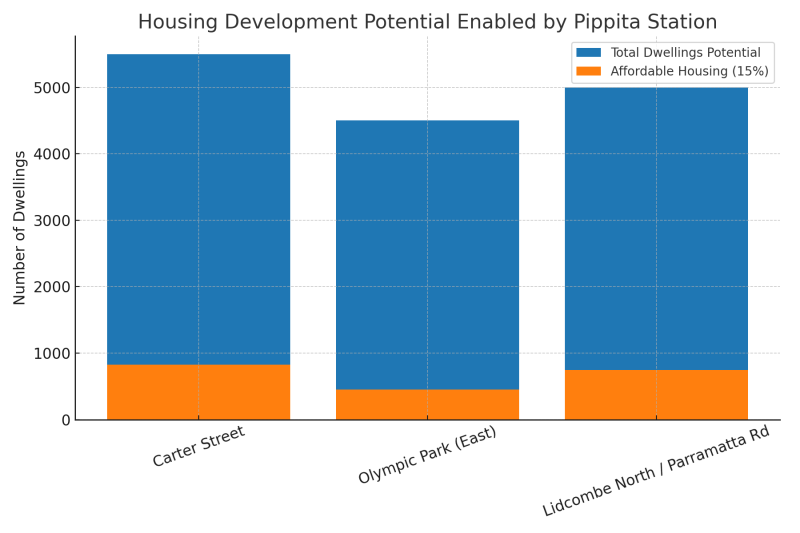
Risks and Delivery
Key risks include timetable conflicts at Strathfield Junction, which can be mitigated by initially introducing through-services during off-peak periods. There is also a risk of slower-than-expected patronage growth, which can be addressed by aligning project delivery with the staged rollout of Carter Street housing. Event crowding risks are low, as Olympic Park will remain the main event hub. Active transport safety concerns can be mitigated through high-quality lighting, landscaping, and separation of pedestrian and cycling paths.
The project would be delivered in two stages: Stage 1 (2026–28) comprising detailed design and station reconstruction, and Stage 2 (2028–30) comprising the construction of the Pippita Rail Trail and the introduction of through-services. Governance would be led by Transport for NSW in partnership with Cumberland and Parramatta Councils and the Sydney Olympic Park Authority.
Funding would come from a mix of sources including developer contributions from Carter Street and Lidcombe North rezonings, the NSW Housing and Productivity Fund, the TfNSW Strategic Station Program, the NSW Active Transport Program, and potential Commonwealth co-funding.
Conclusion
Rebuilding Pippita Station and developing the Pippita Rail Trail provides a rare chance to combine transport, housing, and sustainability outcomes in a single integrated project. It will provide direct rail access for 10,000 Carter Street residents, catalyse renewal in Lidcombe North and along Parramatta Road, relieve pressure on Lidcombe Interchange, and activate the Olympic Park Line as a daily commuter corridor.
The housing potential is significant, with 12,000–16,000 dwellings enabled, including around 2,000 affordable homes. The Rail Trail adds an essential active transport connection, supporting safe and sustainable access.
At a realistic cost of $180–280 million, this project delivers excellent value compared with larger rail expansions. It represents a low-cost, high-impact intervention with benefits that extend across transport, housing, environment, and community outcomes.
The recommendation is to proceed to a Strategic Business Case, with strong joint advocacy by Cumberland City Council, City of Parramatta Council, the Sydney Olympic Park Authority, and community stakeholders including EcoTransit Sydney.
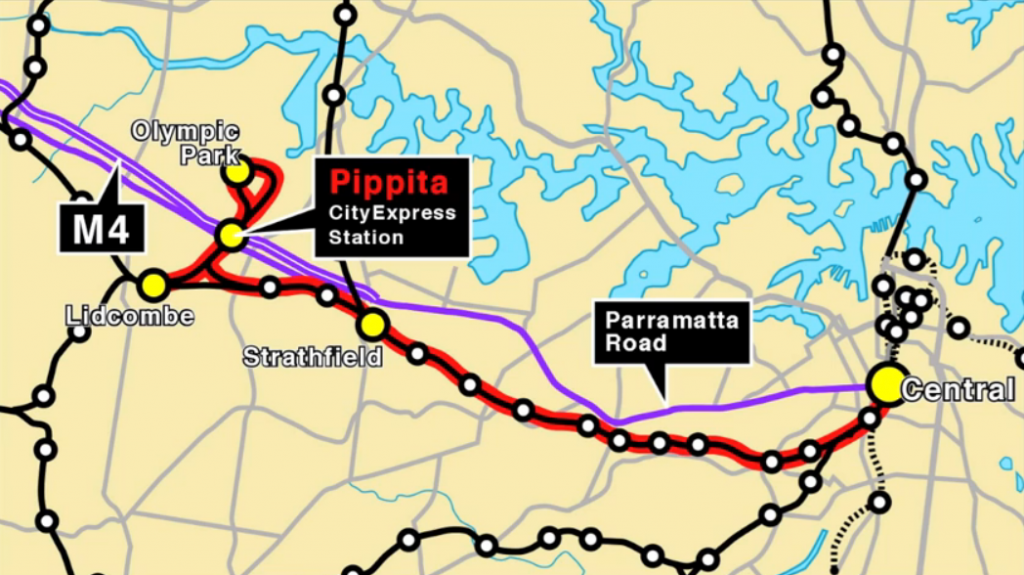
Read more about the EcoTransit campaign for Pippita
